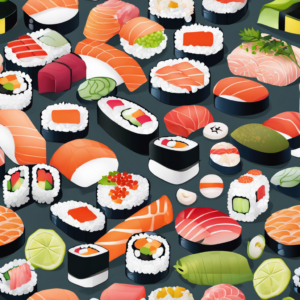Sushi AI: Sushi, the iconic Japanese dish, has undergone various transformations throughout its history. From traditional Edomae-zushi to modern variations like dragon rolls and rainbow rolls, sushi has evolved with the changing culinary landscape. In recent years, another revolution has been quietly unfolding in the world of sushi – the integration of artificial intelligence, giving birth to what enthusiasts fondly call “Sushi AI.”

I. The Art of Sushi Making:
Before delving into the realm of Sushi AI, it’s essential to appreciate the artistry and precision involved in crafting sushi. Sushi chefs, known as itamae, spend years honing their skills to create the perfect balance of flavors and textures. From selecting the freshest fish to mastering the art of rice preparation, sushi making is a meticulous process that demands expertise.
II. The Role of Artificial Intelligence:
In the age of technological advancements, artificial intelligence has found its way into various industries, and the culinary world is no exception. Sushi AI represents the marriage of traditional craftsmanship with cutting-edge technology. One aspect where AI has made significant inroads is recipe development.
III. AI-Generated Sushi Recipes:
Imagine an AI system analyzing vast datasets of flavor profiles, ingredient combinations, and cultural nuances to create innovative sushi recipes. Sushi AI algorithms can predict which combinations are likely to tantalize taste buds, introducing novel flavors and textures that might not have been conceived through traditional methods. This not only expands the culinary landscape but also opens the door to cross-cultural fusions.
IV. Automated Sushi Preparation:
Beyond recipe creation, AI is making waves in the automation of certain aspects of sushi preparation. Sushi restaurants equipped with robotic arms and automated systems can streamline the sushi-making process, ensuring consistency and efficiency. This not only addresses labor shortages but also enhances the overall dining experience by reducing wait times.
V. Personalized Sushi Experiences:
One of the exciting possibilities that Sushi AI brings to the table is the ability to personalize dining experiences. AI algorithms can analyze individual preferences, dietary restrictions, and cultural backgrounds to recommend customized sushi creations. This personal touch adds a new dimension to the dining experience, catering to the unique tastes of each patron.
VI. Challenges and Considerations:
While the integration of AI in sushi-making brings forth numerous benefits, it is not without challenges. Concerns about job displacement, the need for ongoing human supervision, and the ethical implications of relying heavily on technology in culinary arts are all factors that must be carefully considered.
VII. The Future of Sushi AI:
As technology continues to advance, the future of Sushi AI holds exciting possibilities. The ongoing collaboration between culinary experts and AI developers is likely to yield innovations that enhance not only the efficiency of sushi production but also the creativity behind each dish. Sushi AI may become a tool for chefs to push the boundaries of culinary exploration.
Conclusion:
In the evolving landscape of gastronomy, Sushi AI represents a fascinating intersection of tradition and technology. As sushi continues to captivate palates worldwide, the integration of artificial intelligence adds a new layer of creativity and efficiency to this time-honored culinary art. Whether it’s AI-generated recipes, automated preparation, or personalized dining experiences, Sushi AI is poised to leave an indelible mark on the world of sushi. As we savor the flavors of the present, the future promises an exciting journey into the realms of culinary innovation.
